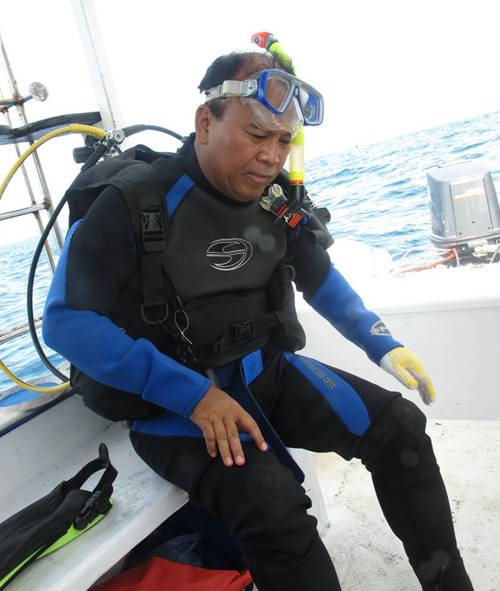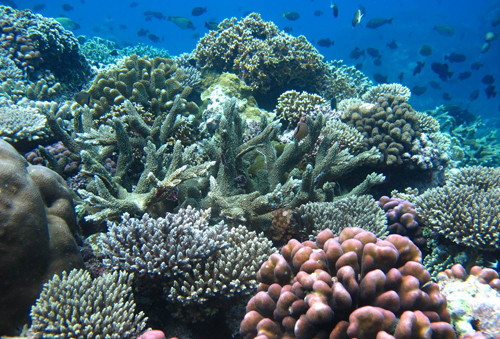The coral reefs of the Banda Islands have some of the most spectacular and resilient reefs in the world. One of the reasons for this is that they are in the heart of the Coral Triangle, the epicenter of marine diversity.
Another is that there are relatively few threats to the reefs here. There is very little land runoff of sediment or nutrients, fishing pressure is low, and—unlike in other areas of Indonesia (and the world)—these reefs do not appear to have experienced a major coral bleaching event.
But since they are located in the Ring of Fire, they do have to cope with special problems—like earthquakes that shake and break fragile corals and volcanic eruptions that cover reefs in lava—that come with being located in a geologically active area.
One of the Banda islands, Gunung Api, is an active volcano, which has erupted six times in the last 400 years(most recently in 1988). During the last eruption, some reefs were covered by lava flow (see photo above).
Based on observations of other volcano-affected reefs in places like Hawaii, scientists feared that the reefs would take a long time to recover (50 years or so).
But that was not the case. In 1993, just five years after the eruption, Dr. Tomas Tomascik (a visiting scientist from Canada) found that there was already 60 percent coral cover on the lava flow. This rapid recolonization of a coral community on a lava flow was unprecedented in the scientific literature.

Dr. Suharsono, the leading coral expert in Indonesia from the National Institute of Science, participated in our survey with us in Banda. Dr. Suharsono also visited the area in 1993 and recorded 70 percent coral cover on the lava flow, noting that some of the coral colonies were already a meter across. In 2002, he revisited the area and found that there was 87 percent coral cover on the lava flow, and some of the coral colonies were already three to four meters across!
Ten years later, and 24 years after the eruption, our survey team revisited the area, and Dr Suharsono confirmed that there is still high coral cover and diversity has increased on the lava flow.

This demonstrates that reefs in this area have such high resilience that they can re-establish coral communities in less than 10 years.
Why is that? It might be because the reefs show many of the characteristics of resilient coral communities—consolidated substrate to settle on, good water quality, high coral recruitment and healthy fish populations. The lava flow is also in a sheltered bay where the corals are protected from wave action.
Or is there something else going on? Dr. Suharsono says that it is possible that the chemical composition of the lava has contributed to this rapid recovery. This is something that needs further investigation, and the Banda Islands provide a wonderful natural laboratory for testing this hypothesis.

(Image 1: Aerial photo of the active volcano Gunung Api, showing the lava flow that entered the sea and covered the reef with lava in 1988. Image 1 credit: Marthen Welly. Image 2: Dr. Suharsono on the marine rapid assessment in Banda this week. Image 2 credit: Marthen Welly. Image 3: High coral cover and diversity on the lava flow in 2012. Image 3 credit: Marthen Welly. Image 4: Large coral colonies on the lava flow in 2012. Image 4 credit: Marthen Welly.)
Source : http://blog.nature.org/2012/11/expedition-to-the-spice islands-corals-and-volcanoes/

Tidak ada komentar:
Posting Komentar